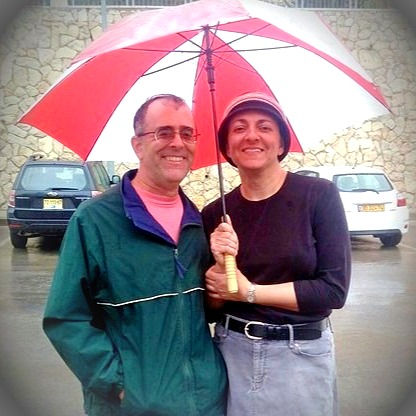Weather: Giving Winter A Shot In The Arm
- Dr. Barry Lynn
- Jan 6, 2020
- 4 min read

Illustration: Storm Clouds Build Over Gush Etzion (Image Credit: Dr. Barry Lynn © 2020)
The roses out front are still blooming. They missed the message that winter has arrived. Or, perhaps they didn't read the minutes of our "Israel Winter Weather" group. We meet in secret every few days to determine what's going to be for both the coming week and the next.
Recriminations have been flying back and forth among those that live in Tel-Aviv and its local government, after 75 millimeters (nearly 3 inches) of rain fell in a couple of hours, overwhelming the sewer and drainage system and resulting in tragic loss of life. Perhaps recriminations are justified as the weather forecast was "spot on" in predicting the rain amounts during this last storm both over coastal cities and in the central mountains.
I am beginning to believe that last year's update to the Global Forecast System (GFS) has enabled an improvement in our own high-resolution forecasts that are themselves based on the GFS (global) data. Yet, like last time, our group is discussing model forecast differences between the GFS (American model) and the European Centre for Medium-Range Weather Forecasts (ECMWF).
Both are again forecasting a rather significant storm to affect our area Wednesday into Thursday night — again with heavy rain, strong winds, and thunderstorms. Both are forecasting this storm to dive to our west, south of Crete. This means that the cold air originally associated with the storm will again moderately warm as it heads our way over the Mediterranean Sea. Rain mixed with snow is possible, but only at very high elevations.
The model differences concern what will follow the next storm. Twenty percent of the GFS ensemble members (from the Global Ensemble Forecast System (GEFS)) suggest that two storms will follow our next. As of last time, this most likely depends on how quickly are next storm progresses eastward away from us. If it moves too fast, as forecast by the European Models, then the next injection of cold air from the polar jet stream will pass by to our east. If not, we could see our first snow.
It's easy to just ask, "What will the weather be?" without accounting for uncertainty in our knowledge of the current state of the atmosphere (especially in the far northern areas where our coldest storms originate). There is also model forecast uncertainty associated with physical algorithms that describe the land, sea, and atmosphere, as well as uncertainty associated with chaotic behavior caused by the need to solve complex non-linear equations using finite differencing on a computer that necessitates round-off error (at the limit of precision of the computer).
The result is that we can usually see several days into the future, but beyond this time frame the forecast becomes much more uncertain. In fact, the only time I remember a winter storm that was apparent in the forecasts even 10-12 days in advance was the very significant snowstorm of December 2013. In this case, the circulation patterns that led to this storm were so strong and well defined that they were resolvable by the forecasts even so far in advance.
People actually live with uncertainty in their lives all the time. We make many decisions based on hunches or optimism. However, given the chance, they will seek certainty when it involves potential personal harm. One such case is the decision to be vaccinated or not.
The vaccine against measles, etc, is very effective and complications are very rare. Yet, sadly, around 140,000 unvaccinated children died of measles in 2018. Unfortunately, there are "supposedly" reputable organizations that suggest otherwise, overlooking the fact that the reason there have been relatively few deaths from measles (percentage wise) is the high rate of vaccination!
Recently, The Times Of Israel noted that this flu season is especially virulent and deadly. In fact, my father remembers his aunt telling him about the Spanish Flu epidemic, which killed more people than those that died in World War I. Folks would get on the trolley as living beings, but be dead before they got off.
One reader of The Times article commented that the strains of flu change too quickly for the vaccines to be effective, and suggested to readers that they instead get a good night sleep and eat plenty of garlic. While it is true that each year's flu vaccine is based in part on guesswork concerning which strains will be present the coming winter, important studies have documented the effectiveness of the flu vaccine as well. Overall, it's not as effective as the standard vaccines, like for the measles, but it can prevent the flu or enable one's body to better fight it off, reducing the terrible flu symptoms associated with the flu viruses.
So, save yourself and those you will infect from being a victim of the flu — get vaccinated!

Dr. Lynn is a lecturer at The Hebrew University of Jerusalem, Earth Sciences Department. He is also CEO of Weather It Is, LTD, a company that specializes in reducing weather risk. Click here to read more of this writer’s work in The Jerusalem Herald.



































Comments